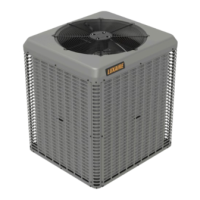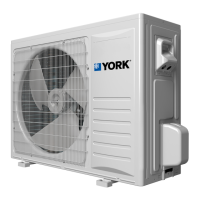20
RB SERIES ENGINEERING GUIDE
The Closed Loop Heat Pump Concept
The basic principle of a water source heat pump is the transfer
of heat into water from the space during cooling, or the transfer
of heat from water into the space during heating. Extremely high
levels of energy efficiency are achieved as electricity is used only
to move heat, not to produce it. Using a typical RB Series, one unit
of electricity will move four to five units of heat.
When multiple water source heat pumps are combined on a
common circulating loop, the ultimate in energy efficiency is
created: The heat pump units on cooling mode are adding heat
to the loop which the units in heating mode can absorb, thus
removing heat from the area where cooling is needed, recovering
and redistributing that heat for possible utilization elsewhere in
the system. In modern commercial structures, this characteristic
of heat recovery from core area heat generated by lighting, office
equipment, computers, solar radiation, people or other sources, is
an important factor in the high efficiency and low operating costs of
closed source heat pump systems.
In the event that a building's net heating and cooling requirements
create loop temperature extremes, RB Series units have the
extended range capacity and versatility to maintain a comfortable
environment for all building areas. Excess heat can be stored
for later utilization or be added or removed in one of three ways;
by ground-source heat exchanger loops: plate heat exchangers
connected to other water sources, or conventional cooler/boiler
configurations. Your sales representative has the expertise and
computer software to assist in determining optimum system type
for specific applications.
The Closed Loop Advantage
A properly applied water source heat pump system offers many
advantages over other systems. First costs are low because
units can be added to the loop on an “as needed basis”- perfect
for speculative buildings. Installed costs are low since units are
self-contained and can be located adjacent to the occupied
space, requiring minimal ductwork. Maintenance can be done
on individual units without system shut-down. Conditions remain
comfortable since each unit operates separately, allowing cooling
in one area and heating in another. Tenant spaces can be
finished and added as needed. Power billing to tenants is also
convenient since each unit can be individually metered: each pays
for what each uses. Nighttime and/or weekend uses of certain
areas are possible without heating or cooling the entire facility.
A decentralized system also means if one unit should fault, the
rest of the system will continue to operate normally, as well as
eliminating air cross-contamination problems and expensive high
pressure duct systems requiring an inefficient electric resistance
reheat mode.
The RB Series Approach
There are a number of proven choices in the type of RB Series
system which would be best for any given application. Most often
considered are:
• Closed Loop/Ground-Source Systems utilize the stable
temperatures of the earth to maintain proper water source
temperatures (via vertical or horizontal closed loop heat exchangers)
for RB Series extended range heat pump system. Sizes range from
a single unit through many hundreds of units. When net cooling
requirements cause closed loop water temperatures to rise, heat is
dissipated into the cooler earth through buried high strength plastic
pipe “heat exchangers.” Conversely if net space heating demands
cause loop heat absorption beyond that heat recovered from building
core areas, the loop temperature will fall causing heat to be extracted
from the earth. Due to the extended loop temperatures, AHRI/ISO
13256-1 Ground Loop Heat Pumps are required for this application.
Application Notes
Supply Water
Return Water
Pumps
RB Series
Unit
RB Series
Unit
RB Series
Unit
RB Series
Unit
RB Series
Unit
RB Series
Unit
Heater/
Rejector
Vertical - Closed Loop/Ground Source

